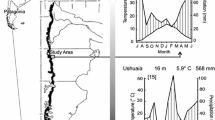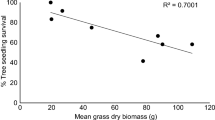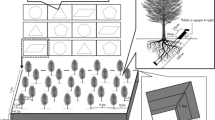Abstract
A better understanding of root/shoot interactions influencing seedling growth on abandoned land could yield insight into seedling regeneration and restoration of the abandoned lands. Field work had been conducted for 2 years (2008–2009) to investigate the impacts of neighbouring plants on Manchurian Ash (Fraxinus mandshurica) seedling growth under the canopy of an old secondary forest and on the abandoned land exposed to full solar radiation in North-eastern China. Four different interaction treatments were designed for the study: neither shoot nor root interaction, shoot interaction only, root interaction only, and both shoot and root interaction. The presence of either the shoots or roots of neighbours had a competitive effect, reducing the growth of the target seedlings at each site. The total competitive effect of roots and shoots of neighbouring plants was significantly less than the sum of root and shoot competition separately on the abandoned land, but this difference was not significant beneath the forest canopy. Root competition was more restraining than shoot competition on the abandoned land. Target seedlings adjusted their root morphology and growth rates in response to the competitive effects from different parts of the neighbouring plants. Our results indicated that the root:shoot ratios of the target seedlings at the end of the experiment were affected by neither initial tree size nor the competition from either above- or belowground at either site. The results also highlight the importance of reducing root competition in boosting seedling regeneration and forest rehabilitation on the abandoned land.




Similar content being viewed by others
References
Bertness MD, Callaway RM (1994) Positive interactions in communities. Trends Ecol Evol 9:191–193
Bertness MD, Ewanchuk PJ (2002) Latitudinal and climate-driven variation in the strength and nature of biological interactions in New England salt marshes. Oecologia 132:392–401
Bertness MD, Leonard GH (1997) The role of positive interactions in communities: lessons from intertidal habitats. Ecology 78:1976–1989
Bonhomme R, Chartier P (1972) The interpretation and automatic measurement of hemispherical photographs to obtain sunlit foliage area and gap frequency. Isr J Agr Res 22:53–61
Brooker RW, Callaghan TV (1998) The balance between positive and negative plant interactions and its relationship to environmental gradients: a model. Oikos 81:196–207
Brooker RW, Scott D, Palmer SCF, Swaine E (2006) Transient facilitative effects of heather on Scots pine along a grazing disturbance gradient in Scottish moorland. J Ecol 94:637–645
Brooker RW, Maestre FT, Callaway RM, Lortie CL, Cavieres LA, Kunstler G, Liancourt P, Tielbörger K, Travis JMJ, Anthelme F, Armas C, Coll L, Corcket E, Delzon S, Forey E, Kikvidze Z, Olofsson J, Pugnaire F, Quiroz CL, Saccone P, Schiffers K, Seifan M, Touzard B, Michalet R (2008) Facilitation in plant communities: the past, the present, and the future. J Ecol 96:18–34
Cahill JF (1999) Fertilization effects on interactions between above- and belowground competition in an old field. Ecology 80:466–480
Cahill JF (2002) Interactions between root and shoot competition vary among species. Oikos 99:101–112
Cahill JF (2003) Lack of relationship between belowground competition and allocation to roots in 10 grassland species. J Ecol 91:532–540
Callaway RM, Brooker RW, Choler P, Kikvidze Z, Lortie CJ, Michalet R, Paolini L, Pugnaire FI, Newingham B, Aschehoug ET, Armas C, Kikodze D, Cook BJ (2002) Positive interactions among alpine plants increase with stress. Nature 417:844–848
Callaway RM, Pennings SC, Richards CL (2003) Phenotypic plasticity and interactions among plants. Ecology 84:1125–1128
Canham CD, Kobe RK, Latty EF, Chazdon RL (1999) Interspecific and intraspecific variation in tree seedling survival: effects of allocation to roots versus carbohydrate reserves. Oecologia 121:1–11
Casper BB, Cahill JF, Hyatt LA (1998) Above-ground competition does not alter biomass allocated to roots in Abutilon theophrasti. New Phytol 140:231–238
Chazdon RL (2008) Beyond deforestation: restoring forests and ecosystem services on degraded lands. Science 320:1458–1460
Clements FE, Weaver JE, Hanson HC (1929) Plant competition: an analysis of community functions. Carnegie Institute, Washington, DC
Donald CM (1958) The interaction of competition for light and for nutrients. Aust J Agr Res 9:421–435
Goldberg DE, Barton AM (1992) Patterns and consequences of interspecific competition in natural communities: a review of field experiments with plants. Am Nat 139:771–801
Grime JP, Hodgson JG (1987) Botanical contributions to contemporary ecological theory. New Phytol 106:283–295
Griscom HP, Griscom BW, Ashton MS (2009) Forest regeneration from pasture in the dry tropics of Panama: effects of cattle, exotic grass, and forested riparia. Restor Ecol 17:117–126
Grubb PJ, Lee WG, Kollmann J, Wilson JB (1996) Interaction of irradiance and soil nutrient supply on growth of seedlings of ten European tall–shrub species and Fagus sylvatica. J Ecol 84:827–840
Gunaratne AMTA, Gunatilleke CVS, Gunatilleke IAUN, Madawala Weerasinghe HMSP, Burslem DFRP (2010) Barriers to tree seedling emergence on human-induced grasslands in Sri Lanka. J Appl Ecol 47:157–165
Gunaratne AMTA, Gunatilleke CVS, Gunatilleke IAUN, Madawala Weerasinghe HMSP, Burslem DFRP (2011) Release from root competition promotes tree seedling survival and growth following transplantation into human-induced grasslands in Sri Lanka. For Ecol Manage 262:229–236
Hedges LV, Gurevitch J, Curtis PS (1999) The meta-analysis of response ratios in experimental ecology. Ecology 80:1150–1156
Holl KD (1998) Effects of above- and below-ground competition of shrubs and grass on Calophyllum brasiliense (Camb.) seedling growth in abandoned tropical pasture. For Ecol Manage 109:187–195
Holl KD, Loik ME, Lin EHV, Samuels IA (2000) Tropical montane forest restoration in Costa Rica: overcoming barriers to dispersal and establishment. Restor Ecol 8:339–349
Holmgren M, Scheffer M, Huston MA (1997) The interplay of facilitation and competition in plant communities. Ecology 78:1966–1975
Hooper E, Condit R, Legendre P (2002) Responses of 20 native tree species to reforestation strategies for abandoned farmland in Panama. Ecol Appl 12:1626–1641
Hooper ER, Legendre P, Condit R (2004) Factors affecting community composition of forest regeneration in deforested, abandoned land in Panama. Ecology 85:3313–3326
Jensen AM, Löf M, Gardiner ES (2011) Effects of above- and below-ground competition from shrubs on photosynthesis, transpiration and growth in Quercus robur L. seedlings. Environ Exp Bot 71:367–375
Kalembasa SJ, Jenkinson DS (1973) A comparative study of titrimetric and gravimetric methods for the determination of organic carbon in soil. J Sci Food Agr 24:1085–1090
Keddy PA (2001) Competition, 2nd edn. Kluwer, Dordrecht
Kikvidze Z, Suzuki M, Brooker R (2011) Importance versus intensity of ecological effects: why context matters. Trends Ecol Evol 26:383–388
Lamb D (1998) Large-scale ecological restoration of degraded tropical forest lands: the potential role of timber plantations. Restor Ecol 6:271–279
Loik ME, Holl KD (1999) Photosynthetic responses to light for rainforest seedlings planted in abandoned pasture, Costa Rica. Restor Ecol 7:382–391
Luo W, Xie Y, Chen X, Li F, Qin X (2010) Competition and facilitation in three marsh plants in response to a water-level gradient. Wetlands 30:525–530
Manly BFJ (1997) Randomization, bootstrap and Monte Carlo methods in biology. Chapman and Hall, New York
Messier C, Nikinmaa E (2000) Effects of light availability and sapling size on the growth, biomass allocation, and crown morphology of understory sugar maple, yellow birch, and beech. Ecoscience 7:345–356
Mulligan MK, Kirkman LK (2002) Competition effects on wiregrass (Aristida beyrichana) growth and survival. Plant Ecol 167:39–50
Nepstad DC, Uhl C, Pereira CA, da Silva JMC (1996) A comparative study of tree establishment in abandoned pasture and mature forest of eastern Amazonia. Oikos 76:25–39
Newman EI (1973) Competition and diversity in herbaceous vegetation. Nature 244:311
Pennings SC, Selig ER, Houser LT, Bertness MD (2003) Geographic variation in positive and negative interactions among salt marsh plants. Ecology 84:1527–1538
Posada JM, Aide TM, Cavelier J (2000) Cattle and weedy shrubs as restoration tools of tropical montane rainforest. Restor Ecol 8:370–379
Pregitzer KS, DeForest JL, Burton AJ, Allen MF, Ruess RW, Hendrick RL (2002) Fine root architecture of nine north american trees. Ecol Monogr 72:293–309
Pruden G, Powlson DS, Jenkinson DS (1985) The measurement of 15N in soil and plant material. Nutr Cycl Agroecosys 6:205–218
Pugnaire FI, Armas C, Maestre FT (2011) Positive plant interactions in the Iberian Southeast: mechanisms, environmental gradients, and ecosystem function. J Arid Environ 75:1310–1320
Putz FE, Canham CD (1992) Mechanisms of arrested succession in shrublands: root and shoot competition between shrubs and tree seedlings. For Ecol Manage 49:267–275
Schall P, Lödige C, Beck M, Ammer C (2012) Biomass allocation to roots and shoots is more sensitive to shade and drought in European beech than in Norway spruce seedlings. For Ecol Manage 266:246–253
Schiffers K, Tielbörger K (2006) Ontogenetic shifts in interactions among annual plants. J Ecol 94:336–341
Semchenko M, Lepik M, Götzenberger L, Zobel K (2011) Positive effect of shade on plant growth: amelioration of stress or active regulation of growth rate? J Ecol 100:459–466
Shipley B, Meziane D (2002) The balanced-growth hypothesis and the allometry of leaf and root biomass allocation. Funct Ecol 16:326–331
Slocum MG, Horvitz CC (2000) Seed arrival under different genera of trees in a neotropical pasture. Plant Ecol 149:51–62
Song M, Tian Y, Xu X, Hu Q, Ouyang H (2006) Interactions between root and shoot competition among four plant species in an alpine meadow on the Tibetan Plateau. Acta Oecol 29:214–220
Song M, Hu Q, Tian Y, Ouyang H (2012) Seasonal patterns of root and shoot interactions in an alpine meadow on the Tibetan Plateau. J Plant Ecol 5:182–190
Tielbörger K, Kadmon R (2000) Temporal environmental variations tips the balance between facilitation and interference in desert plants. Ecology 81:1544–1553
Travis JM, Brooker RW, Dytham C (2005) The interplay of positive and negative species interactions across an environmental gradient: insights from an individual-based simulation model. Biol Lett 1:5–8
Van Hees AFM, Clerkx APPM (2003) Shading and root–shoot relations in saplings of silver birch, pedunculate oak and beech. For Ecol Manage 176:439–448
Weiner J (1986) How competition for light and nutrients affects size variability in Ipomoea tricolor populations. Ecology 67:1425–1427
Wilson JB (1988) Shoot competition and root competition. J Appl Ecol 25:279–296
Wilson WG, Nisbet RM (1997) Cooperation and competition along smooth environmental gradients. Ecology 78:2004–2017
Zhang K, Dang H, Tan S, Wang Z, Zhang Q (2010) Vegetation community and soil characteristics of abandoned agricultural land and pine plantation in the Qinling Mountains, China. For Ecol Manage 259:2036–2047
Acknowledgments
We thank Dr. X.P. Wang for his useful suggestion in the revision and two anonymous referees for their valuable comments on an earlier version of the manuscript. This research is supported by the Special Research Program for Forestry Welfare of China (Grant No. 200904022; 201004002) and the 12th five-year National Science and Technology plan of China (Grant No. 2012BAC01B03). Rothamsted Research receives grant aided support from the Biotechnology and Biological Science Research Council (BBSRC), UK.
Author information
Authors and Affiliations
Corresponding author
Additional information
Communicated by C. Ammer.
Electronic supplementary material
Below is the link to the electronic supplementary material.
Rights and permissions
About this article
Cite this article
Wang, J., Wu, L., Zhao, X. et al. Influence of ground flora on Fraxinus mandshurica seedling growth on abandoned land and beneath forest canopy. Eur J Forest Res 132, 313–324 (2013). https://doi.org/10.1007/s10342-012-0676-8
Received:
Revised:
Accepted:
Published:
Issue Date:
DOI: https://doi.org/10.1007/s10342-012-0676-8




